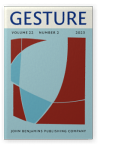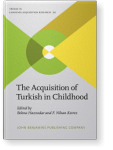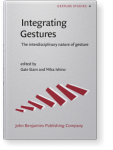Şeyda Özçalışkan
List of John Benjamins publications for which Şeyda Özçalışkan plays a role.
Journal
Title
Social Environment and Cognition in Language Development: Studies in honor of Ayhan Aksu-Koç
Edited by F. Nihan Ketrez, Aylin C. Küntay, Şeyda Özçalışkan and Aslı Özyürek
[Trends in Language Acquisition Research, 21] 2017. xii, 242 pp.
Subjects Language acquisition | Psycholinguistics | Theoretical linguistics
Articles
2017 Introduction Social Environment and Cognition in Language Development: Studies in honor of Ayhan Aksu-Koç, Ketrez, F. Nihan, Aylin C. Küntay, Şeyda Özçalışkan and Aslı Özyürek (eds.), pp. vii–xii | Miscellaneous
2017 Chapter 9. Crossing the road or crossing the mind: How differently do we move across physical and metaphorical spaces in speech and in gesture? Motion and Space across Languages: Theory and applications, Ibarretxe-Antuñano, Iraide (ed.), pp. 257–278 | Chapter
Physical motion constitutes a key aspect of human sensorimotor experience; it also serves as an important experiential domain with which we structure abstract concepts. Moreover, speakers of different languages both talk and gesture about physical motion (e.g. Boy runs through park) in… read more
2017 Chapter 5. How robust is the effect of parental response to child gesture in facilitating child vocabulary development across different learners? Social Environment and Cognition in Language Development: Studies in honor of Ayhan Aksu-Koç, Ketrez, F. Nihan, Aylin C. Küntay, Şeyda Özçalışkan and Aslı Özyürek (eds.), pp. 69–84 | Chapter
Children express their burgeoning abilities in referential communication initially in gesture. Parents frequently provide verbal labels for the referents children express only in gesture but not yet in speech, which, in turn boosts children’s subsequent vocabulary development. In this chapter, we… read more
2016 Learning to think, talk, and gesture about motion in language-specific ways: Insights from Turkish The Acquisition of Turkish in Childhood, Haznedar, Belma and F. Nihan Ketrez (eds.), pp. 177–191 | Article
Languages differ systematically in the way they express spatial motion, rendering it as a highly relevant domain to examine effects of language on nonverbal representation of events. In this chapter, we focus on Turkish and English, the two languages that differ strongly in their expression of… read more
2011 Chapter 12. Is there an iconic gesture spurt at 26 months? Integrating Gestures: The interdisciplinary nature of gesture, Stam, Gale and Mika Ishino (eds.), pp. 163–174 | Chapter
Previous research has shown that children understand the iconicity of a gesture at 26 months. Here we ask when children begin to display an appreciation of iconicity in the gestures they produce. We observed spontaneous gesture in 40 children interacting with their parents from 14 to 34 months of… read more
2004 Typological variation in encoding the manner, path, and ground components of a metaphorical motion event Annual Review of Cognitive Linguistics: Volume 2, Ruiz de Mendoza Ibáñez, Francisco José (ed.), pp. 73–102 | Article
The paper compares two typologically distinct languages with regard to their lexicalization patterns in encoding metaphorical motion events: (1) verb-framed (V-language, represented by Turkish), in which the preferred pattern for framing motion events is the use of a path verb with an optional… read more





